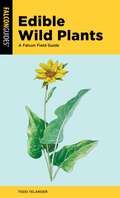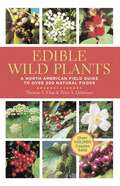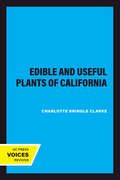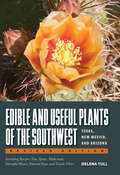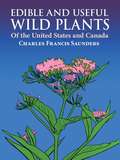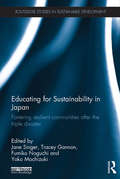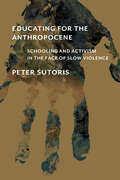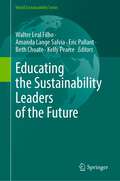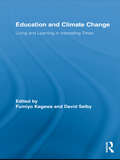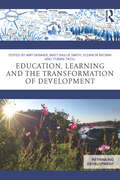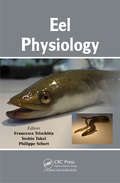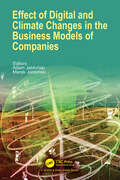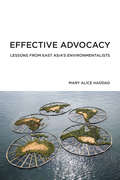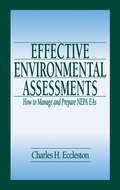- Table View
- List View
Edible Wild Plants: A Falcon Field Guide
by Todd TelanderFully revised and updated, Edible Wild Plants highlights ninety of the most common and sought-after edible plant species in North America. Detailed illustrations and descriptions make it easy to identify plants in your backyard and beyond. Organized by family for easy identification, this is the essential source when you&’re out in the field.
Edible Wild Plants: A North American Field Guide to Over 200 Natural Foods
by Thomas Elias Peter DykemanPlanning an outdoor adventure? Make sure to consult this information-packed and photo-filled North American field guide—arranged by season and region—before you go! <p><p> Already a huge success in previous editions, this must-have field guide now features a fresh new cover, as well as nearly 400 color photos and detailed information on more than 200 species of edible plants all across North America. <p><p> With all the plants conveniently organized by season, enthusiasts will find it very simple to locate and identify their desired ingredients. Each entry includes images, plus facts on the plant’s habitat, physical properties, harvesting, preparation, and poisonous look-alikes. The introduction contains tempting recipes and there’s a quick-reference seasonal key for each plant.
Edible Wild Plants: Wild Foods From Dirt To Plate (The\wild Food Adventure Ser.)
by John KallasThe founder of Wild Food Adventures presents the definitive, fully illustrated guide to foraging and preparing wild edible greens.Beyond the confines of our well-tended vegetable gardens, there is a wide variety of fresh foods growing in our yards, neighborhoods, or local woods. All that&’s needed to take advantage of this wild bounty is a little knowledge and a sense of adventure. In Edible Wild Plants, wild foods expert John Kallas covers easy-to-identify plants commonly found across North America. The extensive information on each plant includes a full pictorial guide, recipes, and more.This volume covers four types of wild greens:Foundation Greens: wild spinach, chickweed, mallow, and purslaneTart Greens: curlydock, sheep sorrel, and wood sorrelPungent Greens: wild mustard, wintercress, garlic mustard, and shepherd&’s purseBitter Greens: dandelion, cat&’s ear, sow thistle, and nipplewort
Edible and Medicinal Mushrooms of New England and Eastern Canada: A Photographic Guidebook to Finding and Using Key Species
by David L. SpahrThis beautifully illustrated guidebook provides specific, easy-to-understand information on finding, collecting, identifying, and preparing the safer and more common edible and medicinal mushroom species of New England and Eastern Canada. Author David Spahr, a trained commercial photographer, here combines his mycological expertise and photographic skill to produce an attractive and detailed overview of his subject. Based on decades of practical experience and research, the book is written in a clear and forthright style that avoids the dry, generic descriptions of most field guides. Edible and Medicinal Mushrooms of New England and Eastern Canada also provides useful ideas for cooking mushrooms. Rather than simply providing recipes, the book discusses the cooking characteristics of each variety, with advice about matching species with appropriate foods. Many mushrooms contain unique medicinal components for boosting the immune system to fight cancer, HIV, and other diseases, and Spahr offers practical and prudent guidelines for exploration of this rapidly emerging area of alternative therapeutic practice.
Edible and Useful Plants of California (California Natural History Guides #41)
by Charlotte Bringle ClarkeBoth American Indians and the pioneers knew and used many different plant species-for food, fibers, medicine, tools, and other purposes. This unique book is a guide to identifying more than 220 such plants. But it goes much further-it also tells the reader how to prepare, cook, and otherwise use them. Some of the dishes for which recipes are given have won culinary prizes. All have been tested not only by the author but also by her students and by journalists-who have been uniformity surprised and impressed.The plants are organized by habitat communities. Description, photos, drawings, and distribution information are given. Where poisonous look-alikes exist, they too are illustrated. Much fascinating information about Indian uses of native and introduced species is included. The author emphasizes conservation considerations; the aim of the book is to educate the reader about intriguing uses of the plants, and to tell how to gather and use the most palatable and abundant species without damaging the environment.
Edible and Useful Plants of the Southwest: Texas, New Mexico, and Arizona
by Delena TullA guide to useful Southwestern wild plants, including recipes, teas, spices, dyes, medicinal uses, poisonous plants, fibers, basketry, and industrial uses.All around us there are wild plants useful for food, medicine, and clothing, but most of us don&’t know how to identify or use them. Delena Tull amply supplies that knowledge in this book, which she has now expanded to more thoroughly address plants found in New Mexico and Arizona, as well as Texas.Extensively illustrated with black-and-white drawings and color photos, this book includes the following special features:· Recipes for foods made from edible wild plants· Wild teas and spices· Wild plant dyes, with instructions for preparing the plants and dying wool, cotton, and other materials· Instructions for preparing fibers for use in making baskets, textiles, and paper· Information on wild plants used for making rubber, wax, oil, and soap· Information on medicinal uses of plants· Details on hay fever plants and plants that cause rashes· Instructions for distinguishing edible from poisonous berries Detailed information on poisonous plants, including poison ivy, oak, and sumac, as well as herbal treatments for their rashes
Edible and Useful Plants of the Southwest: Texas, New Mexico, and Arizona
by Delena TullA guide to useful Southwestern wild plants, including recipes, teas, spices, dyes, medicinal uses, poisonous plants, fibers, basketry, and industrial uses.All around us there are wild plants useful for food, medicine, and clothing, but most of us don&’t know how to identify or use them. Delena Tull amply supplies that knowledge in this book, which she has now expanded to more thoroughly address plants found in New Mexico and Arizona, as well as Texas.Extensively illustrated with black-and-white drawings and color photos, this book includes the following special features:· Recipes for foods made from edible wild plants· Wild teas and spices· Wild plant dyes, with instructions for preparing the plants and dying wool, cotton, and other materials· Instructions for preparing fibers for use in making baskets, textiles, and paper· Information on wild plants used for making rubber, wax, oil, and soap· Information on medicinal uses of plants· Details on hay fever plants and plants that cause rashes· Instructions for distinguishing edible from poisonous berries Detailed information on poisonous plants, including poison ivy, oak, and sumac, as well as herbal treatments for their rashes
Edible and Useful Wild Plants of the United States and Canada
by Charles F. SaundersThis work discusses beverage plants, vegetable substitutes for soap, medicinal plants, and those that can be used as fibers, dyes, smoking material, adhesives, and candles. A final chapter describes a variety of poisonous plants. "Secure a copy of this very enlightening book. In fact, if you travel, it should be a constant companion." -- St. Petersburg Independent. 94 illustrations.
Educating for Sustainability in Japan: Fostering resilient communities after the triple disaster (Routledge Studies in Sustainable Development)
by Jane Singer Tracey Gannon Fumiko Noguchi Yoko MochizukiEducating for Sustainable Development (ESD) approaches are holistic and interdisciplinary, values-driven, participatory, multi-method, locally relevant and emphasize critical thinking and problem-solving. This book explains how ESD approaches work in the Japanese context; their effects on different stakeholders; and their ultimate potential contribution to society in Japan. It considers ESD in both formal and informal education sectors, recognizing that even when classroom learning takes place it must be place-based and predicated on a specific community context. The book explores not only ‘Why ESD’, but why and how ESD in Japan has gained importance in the past decade and more recently in the wake of the triple disaster of March 2011. It considers how ESD can help Japan recover and adapt to disasters and take initiative in building more resilient and sustainable communities. This volume asks the questions: What are some examples of positive contributions by ESD to sustainability in Japan? What is the role of ESD in Japan in activating people to demand and work towards change? How can schools, universities and non-governmental organizations link with communities to strengthen civic awareness and community action? After an introduction that elucidates the roots and recent promotion of ESD in Japan, part one of this volume looks at the formal education sector in Japan, while part two examines community-based education and sustainability initiatives. The latter revisits the Tohoku region five years on from the events of March 2011, to explore recovery and revitalization efforts by schools, NGOs and residents. This is an invaluable book for postgraduate students, researchers, teachers and policy makers working on ESD.
Educating for the Anthropocene: Schooling and Activism in the Face of Slow Violence
by Peter SutorisThe work of environmental educators and activists in India and South Africa offers new models for schooling and environmental activism.Education has never played as critical a role in determining humanity&’s future as it does in the Anthropocene, an era marked by humankind&’s unprecedented control over the natural environment. Drawing on a multisited ethnographic project among schools and activist groups in India and South Africa, Peter Sutoris explores education practices in the context of impoverished, marginal communities where environmental crises intersect with colonial and racist histories and unsustainable practices. He exposes the depoliticizing effects of schooling and examines cross-generational knowledge transfer within and beyond formal education. Finally, he calls for the bridging of schooling and environmental activism, to find answers to the global environmental crisis.The onset of the Anthropocene challenges the very definition of education and its fundamental goals, says Sutoris. Researchers must look outside conventional models and practices of education for inspiration if education is to live up to its responsibilities at this critical time. For decades, environmental activist movements in some countries have wrestled with questions of responsibility and action in the face of environmental destruction; they inhabited the mental world of the Anthropocene before much of the rest of the world. Sutoris highlights an innovative research methodology of participatory observational filmmaking, describing how films made by children in the Indian and South African communities provide a window into the ways that young people make sense of the future of the Anthropocene. It is through their capacity to imagine the world differently, Sutoris argues, that education can reinvent itself.
Educating the Sustainability Leaders of the Future (World Sustainability Series)
by Walter Leal Filho Amanda Lange Salvia Eric Pallant Beth Choate Kelly PearceThis book focuses on 'educating the sustainability leaders of the future' and will contribute to the further development of this fast-growing field. As the title suggests, it presents practical experiences related to education, research and extension, the so-called third mission, whereby universities conduct outreach to society as a whole (e.g. to local communities, organisations, industry, and other groups) with the aim of documenting such experiences and making them available to a wide audience. This book is produced by the European School of Sustainability Science and Research (ESSSR), through the Inter-University Sustainable Development Research Programme (IUSDRP) and contains inputs from authors from across all geographical regions. It gives a special emphasis to the participation of future generations on sustainability efforts. The book also discusses examples of initiatives coordinated by universities but involving civil society, the private sector, and public sector (including local, national, and intergovernmental bodies). In particular, it describes practical experiences, partnerships, networks, and training schemes for building capacity aimed at fostering the cause of sustainable development at institutions of higher education. Thanks to its design and the contributions by experts from various areas, it provides a welcome contribution to the literature on sustainable development, and it inspires further works in this field.
Education and Climate Change: Living and Learning in Interesting Times (Routledge Research in Education)
by David Selby Fumiyo KagawaThere is widespread consensus in the international scientific community that climate change is happening and that abrupt and irreversible impacts are already set in motion. What part does education have to play in helping alleviate rampant climate change and in mitigating its worst effects? In this volume, contributors review and reflect upon social learning from and within their fields of educational expertise in response to the concerns over climate change. They address the contributions the field is currently making to help preempt and mitigate the environmental and social impacts of climate change, as well as how it will continue to respond to the ever changing climate situation. With a special foreword by Desmond Tutu, Archbishop Emeritus of Cape Town.
Education and Learning for Sustainable Futures: 50 Years of Learning for Environment and Change (Routledge Research in Education, Society and the Anthropocene)
by Daniella Tilbury Thomas Macintyre Arjen WalsResponding to growing interest in the sustainable development goals (SDGs) and global concern over climate change, this volume provides an analysis of how our understanding of the relationship between environment and education has evolved during the past 50 years.Spanning from the 1972 United Nations Conference on the Human Environment through to the present day, chapters examine whether our approach to education about environmental sustainability is enacting effective change. Examining the evolution of educational approaches to environmental learning, contexts, and themes, this book moves through the decades, from the 1970s until the 2020s, tracking the impact of historical events and shifting sustainability discourses within education. Through historical, research-based analyses, this book recognises patterns, trends, and countertrends that help critically (re)assess the potential of education in creating a world that is more sustainable than current scientific predictions estimate.Proposing a set of key considerations for the future of environmental education, this accessible book will be of value to scholars, researchers, policymakers, and practitioners working within sustainability education, environmental research and policy, and teacher education more broadly.
Education for Sustainability in Tourism
by Gianna Moscardo Pierre BenckendorffSustainability is a dominant theme in tourism practice. Increasingly, research and education of tourism stakeholders is also necessary in improving sustainable tourism practice. This book pays systematic attention to education for sustainability in tourism, and is thus a valuable resource for sustainable tourism educators and scholars. The book is divided into four parts. Part I provides a reference for educators seeking to understand core knowledge areas, ethics, corporate social responsibility and governance. Part II examines issues and processes relevant to understanding tourism and sustainability in the formal educational sector, including universities, vocational training and school settings. Part III explores learning and sustainable tourism in non-institutional settings, including destination communities, coaching and mentoring and visitor learning. The final part provides a collection of cases to illustrate the use of different pedagogies and assessment approaches in education for sustainability in tourism. The book will be accompanied by instructor resources to assist educators teaching in the field.
Education for Sustainable Development: Papers In Honour Of The United Nations Decade Of Education For Sustainable Development (2005-2014)
by David Higgitt Martin Haigh Brian ChalkleyIn 2005, The United Nations launched its Decade of Education for Sustainable Development, which recognises that education, including Higher Education is the key to the change in social attitudes that will be needed to protect the welfare of future generations. This involves helping learners to live as though the future matters and to achieve ecoliteracy. This includes the understanding that personal lifestyle decisions may have consequences, ranging from climate change, through loss of biodiversity, to pollution and resource depletion that may permit environmental degradation on a planetary scale. It also involves helping them to develop the skills needed to cope with such challenges. This international collection of research papers and position statements from special issues of the Journal of Geography in Higher Education and Applied Environmental Education and Communication, written by many of the leading practitioners in the field, aims to provide resources and practical guidance for all seeking to promote and engage in education for a sustainable future. Rabindranath Tagore encouraged each learner to make their actions demonstrate a harmonious union between education and environment. David Orr argued that the world needs people who live well in their places to make the world both habitable and humane and that the main challenge for education is to help learners make their minds fit for life on Earth. This book tries to chart a practical route towards these objectives. This book was previously published as special issues of the Journal of Geography in Higher Education and Applied Environmental Education and Communication
Education for Sustainable Development: The Contribution of Universities (World Sustainability Series)
by Walter Leal Filho Mark Mifsud Laís Viera Trevisan Paul J. PaceAs we confront the daunting challenges of the 21st century—climate change, social inequality, resource depletion, and the loss of biodiversity—the role of education has emerged as a pivotal force in driving transformative change. "Education for Sustainable Development: The Contribution of Universities" is a response to this urgent call for a reimagined educational landscape, one that empowers current and future generations to navigate and address the complexities of sustainability. This book seeks to outline universities' critical role as catalysts for sustainable development. As centres of knowledge creation, innovation, and community engagement, universities possess the unique ability to influence not only individual lives but also societal norms and practices. They are uniquely positioned to integrate sustainability into their curricula, research agendas, and outreach efforts, thus fostering a culture of sustainability that permeates all aspects of academic life. The need for Education for Sustainable Development (ESD) has never been clearer. By emphasising sustainability in higher education, we can raise awareness among students and faculty, inspiring them to become informed and engaged global citizens. This book serves as a comprehensive resource, offering insights, best practices, and real-world examples of how universities around the globe are advancing the principles of ESD. Within this book, the readers will find a rich tapestry of ideas and strategies designed to encourage institutions to embrace sustainability in a holistic manner. From innovative teaching methods to collaborative community partnerships, this collection reflects the diversity of approaches being implemented in universities today. It is our hope that the experiences shared will serve as a source of inspiration for educators, administrators, and policymakers. Ultimately, this book stands as a testament to the belief that education is a powerful tool for creating a more sustainable and equitable world. By fostering a deep understanding of sustainability and its interconnected dimensions, we can equip students with the knowledge and skills necessary to tackle the pressing issues we face. Together, through a collective commitment to Education for Sustainable Development, we can cultivate a better future for generations to come.
Education, Learning and the Transformation of Development (Rethinking Development)
by Amy Skinner, Matt Baillie Smith, Eleanor Brown and Tobias TrollWhilst education has been widely recognised as a key tool for development, this has tended to be limited to the incremental changes that education can bring about within a given development paradigm, as opposed to its role in challenging dominant conceptions and practices of development and creating alternatives. Through a collection of insightful and provocative chapters, this book will examine the role of learning in shaping new discourses and practices of development. By drawing on contributions from activists, researchers, education and development practitioners from around the world, this book situates learning within the wider political and cultural economies of development. It critically explores if and how learning can shape processes of societal transformation, and consequently a new language and practice of development. This includes offering critical accounts of popular, informal and non-formal learning processes, as well as the contribution of indigenous knowledges, in providing spaces for the co-production of knowledge, thinking and action on development, and in terms of shaping the ways in which citizens engage with and create new understandings of ‘development’ itself. This book makes an important and original contribution by reframing educational practices and processes in relation to broader global struggles for justice, voice and development in a rapidly changing development landscape.
Edwin And Emily
by Suzanne WilliamsEdwin decides that his younger sister Emily is a pest, but sometimes she's a nice pest.
Eel Physiology
by Francesca Trischitta Yoshio Takei Philippe SébertEel of the genus Anguilla is an extraordinary fish, which due to its particular life cycle has fascinated biologists and physiologists ever since the pioneering works of Homer H. Schmidt in the 1930s. The Eel has become an excellent model for various aspects of adaptive physiological research. Despite that, several books dealing with eel biology, a
Eel Science (Fisheries Science Series)
by Katsumi Tsukamoto Mari Kuroki Soichi WatanabeThis book is a compilation of eel research and fish migration studies for more than 40 years showing the research history and recent advances in eel studies. Dr. Katsumi Tsukamoto, the esteemed editor of this book, has been actively involved in eel research as one of the leading scientists in the world for a long time, and he and his team successfully collected the fertilized eggs and spawn-condition adult eels from the wild for the first time in the world. This book compiles the essentials of the scientific findings obtained by the editor and his colleagues and reviews the latest references of eel science. Knowledge and information in the book such as a spawning area survey, research on artificial production of glass eels, the discovery of a new species, etc. will attract the reader’s interest, as these are written based on the authors’ experiences. Readers can obtain a comprehensive understanding of eels from various aspects of eel science including the cultural and socio-economic importance of eels and valuable scientific information using state-of-the-art approaches. The book also endeavors to contribute to the conservation of eel species, some of which have been classified as endangered by the IUCN and to promoting harmonious coexistence between humans and nature.
Eels (Superpower Field Guide)
by Rachel Poliquin Nicholas John FrithThis fourth installment in the hilarious and highly illustrated full-color Superpower Field Guide series features Olenka, an ordinary eel. Olenka may be slimy, wiggly, and the color of mud, but never, ever underestimate an eel. Meet Olenka, an ordinary eel. Did I hear you say, &“But aren&’t eels just long slippery slimy fishy-things that . . . hmm . . . . Is there anything else to know about eels?&” You bet your buttons there is! Sit back and hold on tight, because Olenka is going to amaze you with superpowers such as double invisibility and shape-shifting, and the super secret Lair of the Abyss (that means a top-secret deep-sea hideout). In fact, Olenka's life is so impossibly extraordinary, it has baffled the smartest scientists in the world for thousands of years. &“Impossible!&” you say. I say, "you don&’t know eels." But you will. Includes a ruler printed along the edge of the book&’s back cover to aid the observations of young field scientists everywhere!
Effect of Digital and Climate Changes in the Business Models of Companies
by Adam Jabłoński Marek JabłońskiThe aim of the monograph is to present a modern and original approach towards designing and implementation of effective solutions that ensure an induction towards positive climate change. The monograph presents the application of digital business models and strategies combining solutions of digital and climate transformation. The monograph presents a set of digital solutions that change the functioning of technical organizations in a multiple crisis environment. Applied technological management supported by elements of automation and robotics will shape the emergence of new climate services. The described mechanisms for implementing cybersecurity and safety principles will serve to reduce climate threats.
Effective Advocacy: Lessons from East Asia's Environmentalists (American and Comparative Environmental Policy)
by Mary Alice HaddadAn examination of successful environmental advocacy strategies in East Asia that shows how advocacy can be effective under difficult conditions.The countries of East Asia--China, Japan, South Korea, and Taiwan-- are home to some of the most active and effective environmental advocates in the world. And the governments of these countries have adopted a range of innovative policies to fight pollution and climate change: Japan leads the world in emissions standards, China has become the word's largest producer of photovoltaic panels, and Taiwan and Korea have undertaken major green initiatives. In this book, Mary Alice Haddad examines the advocacy strategies that persuaded citizens, governments, and businesses of these countries to change their behavior.
Effective Ecology: Seeking Success in a Hard Science
by Roger D. CousensEcology is one of the most challenging of sciences, with unambiguous knowledge much harder to achieve than it might seem. But it is also one of the most important sciences for the future health of our planet. It is vital that our efforts are as effective as possible at achieving our desired outcomes. This book is intended to help individual ecologists to develop a better vision for their ecology – and the way they can best contribute to science. The central premise is that to advance ecology effectively as a discipline, ecologists need to be able to establish conclusive answers to key questions rather than merely proposing plausible explanations for mundane observations. Ecologists need clear and honest understanding of how we have come to do things the way we do them now, the limitations of our approaches, our goals for the future and how we may need to change our approaches if we are to maintain or enhance our relevance and credibility. Readers are taken through examples to show what a critical appraisal can reveal and how this approach can benefit ecology if it is applied more routinely.Ecological systems are notable for their complexity and their variability. Ecology is, as indicated by the title of this book, a truly difficult science. Ecologists have achieved a great deal, but they can do better. This book aims to encourage early-career researchers to be realistic about their expectations: to question everything, not to take everything for granted, and to make up their own minds.
Effective Environmental Assessments: How to Manage and Prepare NEPA EAs
by J. Peyton Doub Charles EcclestonAlthough upwards of 50,000 Environmental Assessments (EA) are prepared annually, the focus of the National Environmental Policy Acts (NEPA) Regulations is clearly on defining requirements for preparing environmental impact statements. Surprisingly, until now, there has been no authoritative and comprehensive guide on how to prepare Environmental As
